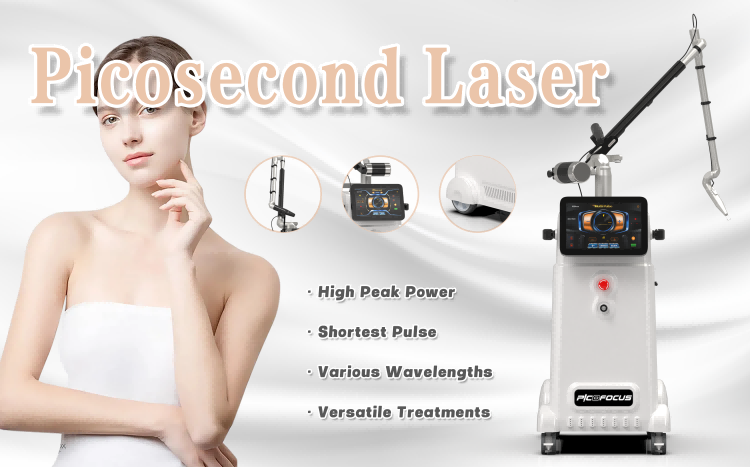
In the field of medical beauty today, picosecond laser has become a milestone technology, widely favored for its excellent efficacy and extremely high safety. For people seeking solutions to various stubborn skin problems, it provides an almost perfect solution.
However, many people still have a partial understanding of its principles and applications. This article will explain the scientific principles of picosecond lasers in a clear and concise manner, comprehensively expound on their diverse clinical applications, and elaborate on the precautions before and after treatment, aiming to provide you with an authoritative and comprehensive science popularization guide on picosecond lasers.
1.From the Photothermal Effect to the Photomechanical Effect: A Technological Paradigm Shift
1.1 The Ultimate Compression of the Time Scale
Picoseconds is a unit of time, where 1 picosecond equals 10-12 seconds. Picosecond laser, as the name suggests, refers to the duration of laser pulses reaching the picosecond level. This creates generational differences compared to the traditional nanosecond laser that we are familiar with (1 nanosecond=billionth of a second, 10-9 seconds). The shorter the pulse width, the higher the peak power of laser energy released in a very short period of time.
1.2 Key Working Principle
The main principle of traditional nanosecond lasers is the photothermal effect. The heat it generates acts on the target pigment group (such as melanin) for a relatively long time, like slowly “boiling” an egg over low heat. This process inevitably causes thermal diffusion to surrounding normal tissues while destroying pigments, which may lead to skin redness, long recovery period, and even the risk of burns or blackening.
The core mechanism of picosecond laser is optomechanical effect. In a trillionth of a second, it applies extremely high energy to pigment particles, causing them to instantly expand due to heat, producing “photoacoustic shock waves” that shatter pigment clusters into extremely small dust like particles. This process is more like using extremely high-frequency sound waves to instantly shake a large stone into powder, rather than slowly heating it up. Due to its extremely short duration of action, there is almost no time for heat to spread to surrounding tissues, thereby minimizing damage to normal skin.

1.3 Technological Advantages of Picosecond Laser
Efficiency: It can more thoroughly crush pigments, making them easier to be engulfed and cleared by the human immune system, resulting in more significant therapeutic effects.
High safety: minimal thermal damage, greatly reducing the risk of postoperative redness, swelling, and anti blackening (pigment deposition after inflammation).
Short recovery period: minimal damage to surrounding tissues means shorter postoperative downtime and faster recovery to normal life.
Wide indications: In addition to pigmentary diseases, the shock waves generated by it can also stimulate the regeneration of deep collagen and elastin.
2.Application of Picosecond Laser: What Skin Issues Can It Solve?
Picosecond laser is not a single functional device. By combining different wavelengths (such as 532nm, 755nm, 1064nm, etc.) and treatment tools, it can accurately solve various skin diseases.
2.1 Tattoo Removal
Whether it’s amateur tattoos or professional colored tattoos, picosecond laser is currently the preferred solution. Its ultra short pulses can effectively shatter ink particles of various colors, especially for blue, green, and other colors that are difficult to remove with traditional nanosecond lasers. Less treatment frequency and higher clearance rate.
2.2 Treat Various Freckles
Sun nevus/age spot: Picosecond laser can accurately locate and crush melanin in the epidermal layer, allowing it to scab and fall off, and restore even skin color.
Freckles: For spot pigmentation caused by genetics and sun exposure, picosecond laser can quickly and cleanly remove them.
Coffee spot: It is a congenital pigmentation that can be effectively reduced in color by picosecond laser.
Ota mole: It is a pigmentary disease of the dermis layer, which can be safely and effectively treated by a specific wavelength of picosecond laser penetrating the dermis layer.
2.3 Improve Melasma
The causes of melasma are complex, and traditional laser treatment carries high risks and is prone to rebound. Picosecond lasers, especially those equipped with special honeycomb lenses, treat melasma through “optomechanical effects” rather than “photothermal effects”, greatly avoiding the deterioration caused by thermal stimulation and becoming a safe and effective treatment option for stable melasma.
2.4 Wrinkle Removal
The photoacoustic shock wave generated by picosecond laser produces a cavitation effect in the dermis layer, which triggers the body’s repair mechanism and generates a large amount of new collagen and elastin, filling fine lines and wrinkles from the root, making the skin more firm and plump.
2.5 Large Pore Shrinking
The enlargement of pores is often related to the active secretion of sebaceous glands and the loss of collagen, leading to skin laxity. Picosecond laser can enhance the support of the skin around pores by stimulating collagen regeneration, thereby achieving effective shrinkage of pores.
2.6 Improve Acne Scars
For concave acne scars such as ice cone and boxcar models, picosecond laser can destroy the collagen fiber arrangement of scar tissue and initiate a new, orderly collagen remodeling process, gradually filling the scars and improving skin smoothness.
2.7 Managing Benign Growths and Vascular Lesions
Warts and seborrheic keratosis: Picosecond laser can vaporize or crush these benign growths, causing them to fall off.
Superficial telangiectasia: Picosecond lasers of specific wavelengths can be absorbed by hemoglobin, blocking abnormal red blood vessels and used to treat conditions such as red blood vessels and spider nevi.

3. Whole Treatment Process: From Consultation to Recovery
3.1 Before Treatment: Make Professional Consultation and Preparations
Interview evaluation: The doctor will inquire in detail about your medical history, medication history, allergy history, and evaluate your skin type, problem type, and severity to determine whether you are a suitable treatment candidate.
Develop a plan: Based on the evaluation results, the doctor will tailor a treatment plan for you, including selecting appropriate wavelengths, energy parameters, and treatment tools.
Preoperative preparation: Strict sun protection is required 2-4 weeks before treatment to avoid direct sunlight exposure. Stop using irritating skincare products such as tretinoin and salicylic acid one week before surgery. On the day of treatment, go without makeup and clean your face.
3.2 During Treatment: Experience and Feeling
Cleaning and anesthesia: The treatment area will be thoroughly cleaned. Depending on the intensity of treatment and your tolerance, surface anesthesia cream may be applied for about 30-60 minutes to alleviate discomfort.
Laser therapy: Doctors will operate laser equipment to scan the treatment area. You will hear a crisp ‘click’ sound and feel a slight tingling sensation similar to a rubber band lightly bouncing your skin. The entire process usually lasts for 15-30 minutes.
3.3 After Treatment: Skin Care and Recovery Period
Immediate response
After treatment, there may be slight redness, swelling, and burning sensation on the skin, which is a normal phenomenon and usually subsides within a few hours to 24 hours.
Performance during the recovery period
Pigmentation problem: Broken pigments will gradually move up to the epidermis as the skin metabolizes, and there may be temporary darkening of color spots and small scabs. After about 5-7 days, they will naturally fall off. Do not pick and scratch on your own.The skin may feel dry and tight, and it is necessary to strengthen moisturizing.
3.4 Important Skin Care Methods
Strict sun protection: This is of utmost importance! After surgery, it is necessary to use broad-spectrum sunscreen with SPF50+and PA++++, combined with physical sunscreen (such as hats and masks).
Gentle cleaning and moisturizing: Use gentle medical restorative skincare products and avoid using irritating ingredients.
Avoid scratching: Let the scab fall off naturally.
Follow the doctor’s advice for follow-up treatment and examination.
Q&A
Q: Does picosecond laser cause pain?
A: The feeling of pain varies from person to person. After applying anesthesia cream, most people can easily tolerate it. The sensation is mostly mild stinging and burning.
Q: How many treatments are needed to see results?
A: It depends on the problem you want to solve. Superficial pigmentation and tattoos may significantly improve after 1-3 treatments. The treatment of skin improvement, wrinkles, and scars requires a process of collagen regeneration, usually requiring 3-5 or more treatments, with an interval of 4-6 weeks between each treatment, and the effect will gradually accumulate and become apparent.
Q: Can picosecond laser cause skin thinning or sensitivity?
A: It won’t. On the contrary, picosecond laser stimulates collagen regeneration, which thickens the dermis layer, improves skin toughness and health, and in the long run helps improve skin sensitivity.





